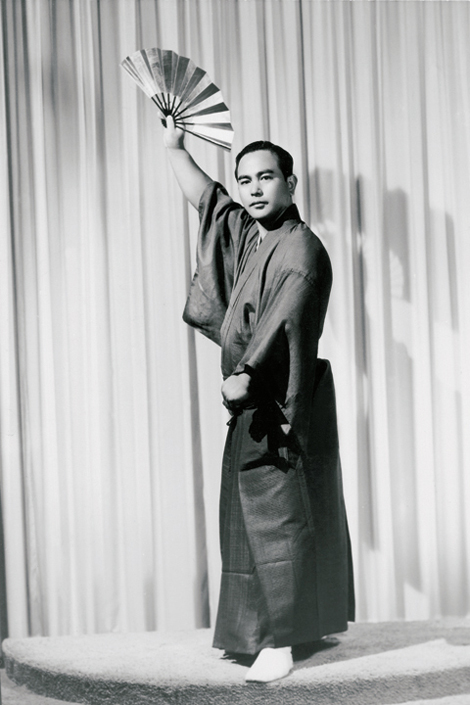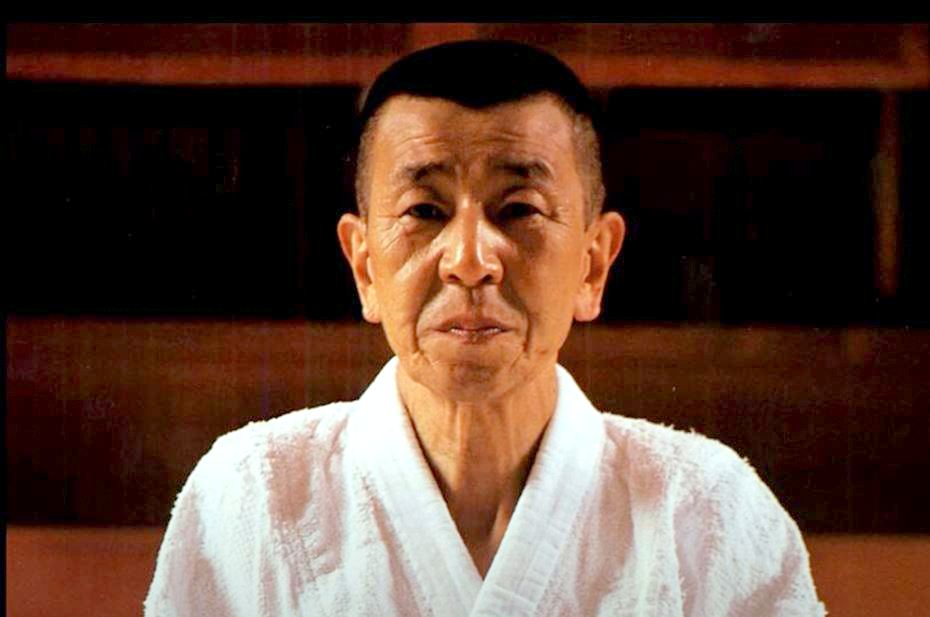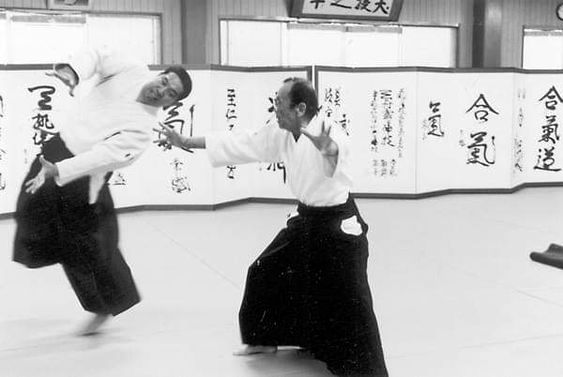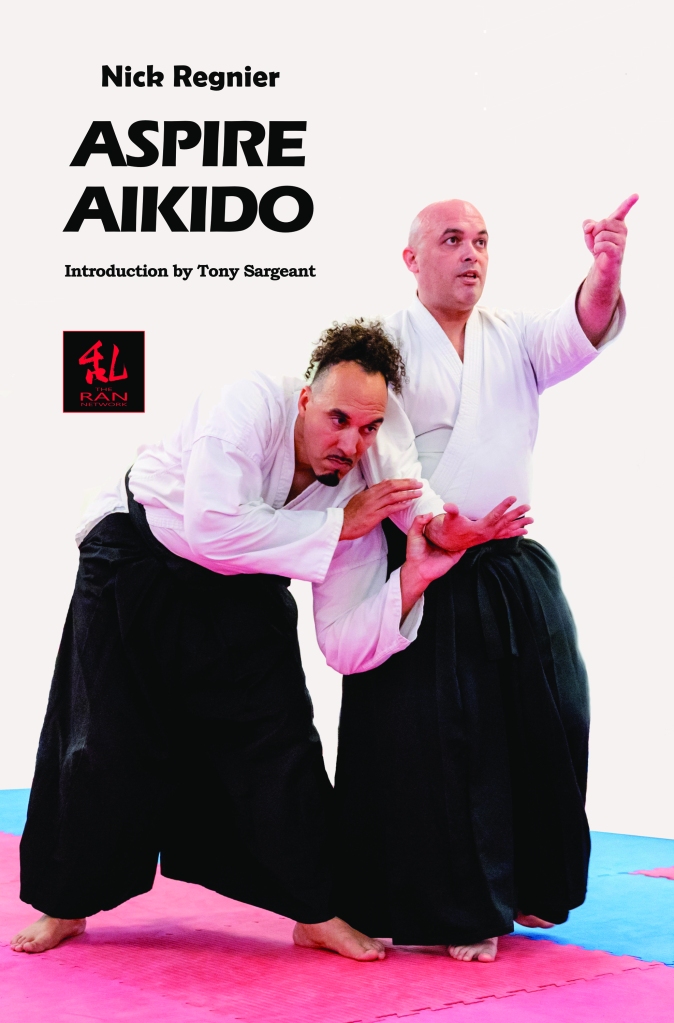
The peak of any art in Budo, receiving the 10th Dan is the equivalent of entering Budo heaven, where only the gods of martial arts are allowed to float. Let’s see together what is the story of 10th Dan in Aikido
by SIMONE CHIERCHINI

The highest-ranking living sensei in Aikikai is currently 9th Dan Hiroshi Tada Shihan, one of the very few remaining post-war students of the founder of Aikido Morihei Ueshiba. The highest grade in Aikido, however, is 10th Dan (Ju-dan). Number Ten, according to Paolo Corallini, has a high symbolic significance:
“The ideogram that expresses this number is a cross 十 (Ju), formed by the union of vertical and horizontal lines, which cross symmetrically to indicate the balance between Heaven and Earth. (…) This number gives to those who own it the sense of the righteous and just human being, the one who, now purified, makes a bridge between Heaven and Earth (pontifex), between the Divine and the human“. [1]
Is that it? Let’s do a little bit of fact-checking.
The most famous Aikido 10th Dan was Koichi Tohei, who was awarded this rank by Morihei Ueshiba himself not long before his death, while Tohei was still at the centre of the Aikikai world and Head Instructor at the Hombu Dojo. Koichi Tohei’s Ju-dan was officially endorsed in 1970 by the Aikikai and a 10th Dan certificate no. 1 was accordingly produced and issued. The one year gap between the awarding of the grade and its registration was explained as part of the mourning following the death of the founder.

This is how Koichi Tohei recalled the 10th Dan affair when interviewed by Stanley Pranin in 1990:
“Two or three days later he started asking me to accept tenth dan. I said, “Sensei, please don’t ask me to do that. If you make me a tenth dan I’ll never hear the end of it!” He agreed to my request and so I remained a ninth dan for the time being. About three years later, however, right before cancer took him, he asked me again. He said to me, “Koichi-chan, please accept the tenth dan.” I felt obliged to agree because it would have been disrespectful to refuse any longer and make him beg me to accept it. It didn’t take long before there were people saying that I wasn’t the only one to have received tenth dan. To avoid the trouble I offered to return the rank, but Mr Osawa intervened and had the number “1” entered on my certificate to verify that it, and not the others, was official. (…) Until I separated from the Aikikai no one else assumed the rank of tenth dan, but as soon as I left everyone started claiming it. (…) He (O’Sensei) was well aware that there was no one to equal me then, and he probably felt that if he didn’t promote me he wouldn’t be able to promote the others. But because he had that child-like quality, he couldn’t wait and went ahead and did it anyway“. [2]
This chevalier attitude towards rank was not unusual in Morihei Ueshiba, as it is proven by other sources. In a 2018 interview by Guillaume Erard, Yasuo Kobayashi, a student at the Aikikai Hombu Dojo since 1955, relates the following:
“Well, when someone did what he liked, O’Sensei would say to that person that he was worth an 8th or a 10th dan, and he would do the same when he went to the countryside. We knew that he was joking but some people took it seriously and came all the way to get a certificate. When that happened, they would argue their case with Kisshomaru Sensei in the office and those who got rejected at the office would talk to O’Sensei and there would be a fight.” [3]
It is Kobayashi sensei that has to offer another interesting insight on how little Morihei Ueshiba thought of ranking:
“About this time there were the following incidents. People came from the countryside suddenly demanding an Aikido 10th dan license. This was because in the old days, when O-Sensei was teaching in the local areas, he would notice someone who, for just a moment, seemed to understand, and he’d say, “Oh, this guy’s got it. I’ll give him a 10th dan”. It seemed he would easily say things like “You’re great! Let’s make you a 9th dan” to people who took him at his word, even though they may have been only a 3rd or 4th dan. That was one face of O-Sensei. He’d just say something like “You’re a 9th dan or 10th dan”. When I was younger, O-Sensei told me, too, many times, that I was a 9th or 10th dan. The other uchi-deshi were also “promoted” to 9th or 10th dan many times. To all of these people who came with such requests, there was the reply that those ranks were not officially recognized, but people would not give up, insisting, “It was said at the time I was promoted to 6th dan by Ueshiba Sensei,” and so forth. It was important for these people that O-Sensei’s recognition be official, with a license. If O-Sensei was there and aware of the situation, he would usually feel exasperated and say, “I authorized them, so what’s the problem?” There were also people who had been promoted to 5th or 6th dan outside of the Aikikai; that was problematical. No simple solution free of problems was possible in many cases. Kisshomaru Sensei thought of granting licenses with O-Sensei’s name. Thus, some certificates were printed with the Aikikai’s name and personally signed by O-Sensei, bypassing the official Aikikai procedure. With these certificates in hand, many of these people returned home happy.” [4]

Koichi Tohei makes reference to other Ju-dan promotions by the founder right after his own. In fact, according to Aikido Geneva Takemusu, on January 10, 1969, Morihei Ueshiba directly granted the 10th Dan to Michio Hikitsuchi. [5] On April 26 of the same year Morihei Ueshiba died in Iwama and Hikitsuchi’s rank remained unsanctioned by the Aikikai Hombu Dojo. Pranin testified that he explicitly asked Doshu Kisshomaru Ueshiba if Hikitsuchi’s 10th Dan had been officially registered by the Aikikai. Kisshomaru had confirmed that this had never happened but had made no further comments. Hikitsuchi made use of the 10th Dan title he received from O’Sensei during his teaching trips abroad. [6]
To corroborate the latter, The New York Times, in the occasion of his 1978 teaching trip to the US, referred to Michio Hikitsuchi as “the world’s highest‐ranking teacher and practitioner of aikido” and “the world’s sole holder of aikido’s highest rank”. [7]
The above Ju-dan promotion didn’t seem to go down too well in the Aikikai Hombu Dojo’s corridors. Even though Yoshimitsu Yamada politely doesn’t call out the culprit’s name, he expresses openly which were the views about the affair at the time of its happening:
“There was a teacher and everybody complained that he was promoted to 10th dan. And believe me, I liked him and it was nothing against him but I know technical aspects. He was way below Tohei Sensei or Saito Sensei. But O-Sensei treated him very well and gave him 10th dan. If O-Sensei gave me 10th dan I wouldn’t believe it. I just would say “Thank you” and wouldn’t make it public. O-Sensei didn’t care about ranks“. [8]
As per Pranin’s testimony, the Aikikai Hombu Dojo never officially recognised that promotion, which means there is no official Aikikai Hombu 10th Dan certificate no. 2 in Michio Hikitsuchi’s name after Tohei’s one. At the same time, Kisshomaru refused to make further comments on the matter, as is often done in Japan when a subject is awkward and explanations may cause more problems than solutions.
It would appear that Ueshiba also verbally awarded the 10th Dan to Seiseki Abe, even though his official rank is 8th Dan. Abe was a Shodo master who had started Aikido under Ueshiba in 1952. The founder developed an interest in Shodo himself and around 1954 asked Abe to teach him calligraphy. The two became very close and in the last years of his life Ueshiba spent one week every month residing in Abe’s home in Osaka, where he studied Shodo and taught Aikido at the traditional dojo Abe built for him just next to his house. Once again, there is no official Aikikai Ju-dan certificate in the name of Seiseki Abe. [9]

More recently, the Aikikai Foundation awarded the 10th Dan rank posthumously to two Aikido giants, Kisaburo Osawa (1910–1991) and Rinjiro Shirata (1912-1993).
There are other Ju-dan in Aikido history, but the relative grades were not awarded by the Aikikai Foundation. These include:
- Minoru Mochizuki – awarded by the International Martial Arts Federation (IMAF) in 1979;
- Yoshio Sugino – awarded by the International Martial Arts Federation (IMAF) in 1982;
- Gozo Shioda – awarded by the International Martial Arts Federation (IMAF) in 1985. Promoted to 9th Dan by Morihei Ueshiba;
- Inoue Kyoichi – awarded by the International Budo Federation (IBF) in 2009.
Minoru Mochizuki’s grade was awarded by the IMAF only after Mochizuki obtained approval by Doshu Kisshomaru Ueshiba. That said, his Ju-dan was not officially sanctioned by the Aikikai Hombu Dojo. [10]
Finally, there is an unknown number of non-Japanese 10th Dan aikidoka. All of them are self-promoted, which is not to say that they are not genuine. Their rank has been given to them by their organisations, which is not uncommon in the world of Budo.
Among them, Michael Williams was conferred the 10th Dan by Koretoshi Maruyama in 2009. Maruyama, the founder of Aikido Yuishinkai, was previously appointed Chief Instructor of the Ki Society by Tohei Sensei and eventually became Tohei Sensei’s designated successor and the President of the Ki Society (he resigned in 1991).
Similarly, holder of 10th Dan in Aikido is Karl E. Geis (1933–2014), also Judo 10th Dan and Jodo 9th Dan. His rank was awarded in 1997 by the Fugakukai International Association. His official rank in Tomiki Aikido is 6th Dan, while he holds a 4th Dan in Kodokan Judo.
A mention, finally, on Real Aikido and its initiator, Ljubomir Vracarevik (1947-2013), who in 2002 was awarded the rank of 10th dan and Sōke by the United States Martial Arts Association (USMAF). No information is available about Vracarevik holding a Dan grade from any recognised Aikido body.
Copyright Simone Chierchini ©2020
All rights reserved. Any unauthorized reproduction is strictly prohibited
Notes:
[1] Corallini Paolo, Dan Grades – A Symbolic Perspective https://simonechierchini.wordpress.com/2020/05/15/dan-grades-a-symbolic-perspective/ (Retrieved 29/05/2020)
[2] Pranin Stanley, Interview with Koichi Tohei, 1990 https://aikidojournal.com/2015/07/07/interview-with-koichi-tohei-1/ (Retrieved 29/05/2020)
[3] Erard Guillaume, Interview with Kobayashi Yasuo: Aikido for Everyone, 2018 https://guillaumeerard.com/aikido/interviews/interview-with-kobayashi-yasuo-shihan/ (Retrieved 29/05/2020)
[4] Kobayashi Yasuo, Aikido, My Way: The Story of Kobayashi Dojos, 2004 http://www.kobayashi-dojo.com/english/book/3_4/
[5] Kunzi Jean-Pierre, Aikido Geneva Takemusu http://www.takemusu-dojo.ch/instructors.html (Retrieved 29/05/2020)
[6] Pranin Stanley, Aikikai Ballistic Over Michio Hikitsuchi’s 10th Dan!, 2016 https://www.youtube.com/watch?v=KU9mpJ_DHwY&w=560&h=315 (Retrieved 29/05/2020)
[7] The New York Times, Visit by World’s No. 1 Master of Aikido, April 17, 1978 https://www.nytimes.com/1978/04/17/archives/visit-by-worlds-no-1-master-of-aikido.html (Retrieved 29/05/2020)
[8] Yamada Yoshimitsu, Interview, 2011 http://www.aikido-yamada.eu/index.php/sensei/interview/ (Retrieved 29/05/2020)
[9] Seiseki Abe Shodo: Aikido, USADojo, 2011 https://www.usadojo.com/seiseki-abe/ (Retrieved 29/05/2020)
[10] Li Christopher, Highest Ranking Aikidoka, Aikiweb, 2001 http://www.aikiweb.com/forums/archive/index.php/t-600.html (Retrieved 29/05/2020)
Nick Regnier: Aspire Aikido
The Ran Network – The Budo Classics #2
“Sometimes I wish I had someone to guide me in choosing which Aikido school to learn from, how to learn the art properly, practice and develop strong Aikido techniques. This book simply tries to be that good guide for you, showing you a different way to think about the Art and practice better Aikido, with a solid focus on finding what I would call strong Aikido.”
Nick Regnier
Nick’s journey in learning Aikido made him realise that “if you don’t train your mind by practicing diligently, you could be wasting a lot of time”. Aikido is more of an “exercise for the mind” than a set of techniques performed with the physical body. Aikido students learn to use mind, body and spirit together to perform techniques. When all three are used, one’s Aikido is infused with strong spirit and feelings, making Aikido techniques come alive.
This book is a collection of Nick’s writings to date. Here he shares his intimate thoughts, offering with candid honesty his explanation of what he believes is behind Aikido, its system, technical methods and purposes. His reflections are influenced primarily by his unique path in Aikido – having practiced in the Aikikai, Yoshinkan and Takemusu Iwama styles – and by his work experience in the security industry. His life experience was also very special, as Nick faced it with a profound hearing disability. Aikido has enormously built his self-confidence and made him ready to face whatever lies ahead.
Nick Regnier started his studies in Aikido in 1988. He follows Iwama Aikido since 1995 and teaches Iwama Aikido at the Aspire Aikido London Dojo.



